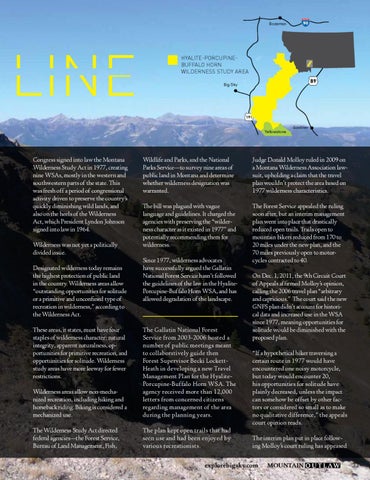Bozeman
Hyalite-PorcupineBuffalo Horn Wilderness Study area Big Sky
Yellowstone
Congress signed into law the Montana Wilderness Study Act in 1977, creating nine WSAs, mostly in the western and southwestern parts of the state. This was fresh off a period of congressional activity driven to preserve the country’s quickly diminishing wild lands, and also on the heels of the Wilderness Act, which President Lyndon Johnson signed into law in 1964. Wilderness was not yet a politically divided issue. Designated wilderness today remains the highest protection of public land in the country. Wilderness areas allow “outstanding opportunities for solitude or a primitive and unconfined type of recreation in wilderness,” according to the Wilderness Act. These areas, it states, must have four staples of wilderness character: natural integrity, apparent naturalness, opportunities for primitive recreation, and opportunities for solitude. Wilderness study areas have more leeway for fewer restrictions. Wilderness areas allow non-mechanized recreation, including hiking and horseback riding. Biking is considered a mechanized use. The Wilderness Study Act directed federal agencies—the Forest Service, Bureau of Land Management, Fish,
Gardiner
Wildlife and Parks, and the National Parks Service—to survey nine areas of public land in Montana and determine whether wilderness designation was warranted.
Judge Donald Molloy ruled in 2009 on a Montana Wilderness Association lawsuit, upholding a claim that the travel plan wouldn’t protect the area based on 1977 wilderness characteristics.
The bill was plagued with vague language and guidelines. It charged the agencies with preserving the “wilderness character as it existed in 1977” and potentially recommending them for wilderness.
The Forest Service appealed the ruling soon after, but an interim management plan went into place that drastically reduced open trails. Trails open to mountain bikers reduced from 170 to 20 miles under the new plan, and the 70 miles previously open to motorcycles contracted to 40.
Since 1977, wilderness advocates have successfully argued the Gallatin National Forest Service hasn’t followed the guidelines of the law in the HyalitePorcupine-Buffalo Horn WSA, and has allowed degradation of the landscape.
The Gallatin National Forest Service from 2003-2006 hosted a number of public meetings meant to collaboratively guide then Forest Supervisor Becki LockettHeath in developing a new Travel Management Plan for the HyalitePorcupine-Buffalo Horn WSA. The agency received more than 12,000 letters from concerned citizens regarding management of the area during the planning years. The plan kept open trails that had seen use and had been enjoyed by various recreationists.
On Dec. 1, 2011, the 9th Circuit Court of Appeals affirmed Molloy’s opinion, calling the 2006 travel plan “arbitrary and capricious.” The court said the new GNFS plan didn’t account for historical data and increased use in the WSA since 1977, meaning opportunities for solitude would be diminished with the proposed plan. “If a hypothetical hiker traversing a certain route in 1977 would have encountered one noisy motorcycle, but today would encounter 20, his opportunities for solitude have plainly decreased, unless the impact can somehow be offset by other factors or considered so small as to make no qualitative difference,” the appeals court opinion reads. The interim plan put in place following Molloy’s court ruling has appeased
explorebigsky.com
Mountain
33
